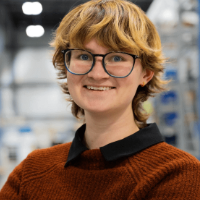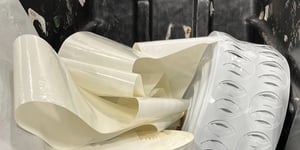It’s Monday morning, and you’re staring at your latest quote with a furrow in your brow. Finally, you crack your knuckles and draft an email:
Dear Adhesive Converter <3,
Based on my calculations, you can make X parts using Y material. Where is the rest of the material going?
Unfortunately, setup waste is unavoidable in converting. However, over the past 38+ years, Strouse has developed effective methods to minimize it.
As you read, you’ll understand why setup waste is inevitable and how reducing said waste decreases the cost of your product.
Where Does Setup Waste in Converting Come From?
It’s impossible to prevent setup waste entirely. The setup waste is more than the edges of the material we don’t use; it includes rolls of material processed while the machine press is starting, stopping, or testing to ensure your tolerances are met.
Similarly, complex products can require “donor materials” to support or guide the main body in a particular direction. These materials eventually become production waste.
How Does Setup Waste Impact Your Cost?
Generally speaking, more setup waste equals a higher cost because you must purchase more materials. Even though you can’t avoid setup waste entirely, various preventable factors can reduce the amount of waste, saving you money.
How To Minimize Setup Waste
Waste disposal is expensive, so it’s in your and your converter’s best interests to reduce it as much as possible. Here are three preemptive measures for you to consider before production:
#1: CHOOSE SIMPLE MATERIALS
The simpler a material is to cut, the fewer defects you’ll encounter. Using a complex material costs more because the die cut testing takes longer to fine-tune, generating more waste.
| Type of Material | Reason for die cut complexity |
|---|---|
| Extremely elastic materials | Elastic materials can make it more difficult to maintain the proper press tension, and ensure the part tolerances remain in spec after being cut instead of shrinking. |
| Abrasive materials | Abrasive materials wear down die tools more quickly than other materials. |
| Extremely compressible materials | Thick, compressible materials tend to cut at a slight angle on a moving press (concave or convex), making it harder to achieve tight tolerances. It will also require more laser passes. |
| Unsupported materials (without a liner) | These materials are more challenging to handle because they tend to be more delicate, which may lead to more cutting errors and create more waste. |
| Extremely thin materials | While thin materials are excellent to die cut, it can require an extremely light touch to remove the material waste matrix (a.k.a., the non-parts) after the fact. |
Adhesive options like foam, elastic, or hydrogel can be more challenging to process, generating more material waste. Flexible and difficult-to-cut materials cost more in waste because they require more testing before running on the press.
Of course, you probably wonder, “What if I have to choose a complex material?” After all, duct tape isn’t the best dressing for an open wound. If you plan on using more complex material for converting, understand that the cost might be higher than expected.
Lastly, if you’re supplying your own material, know that you’ll need to factor in the percentage of waste. Material-to-part conversion is not 1:1. You’ll need to consult your converter on the amount of material the team needs to build you the correct number of units.
#2: REFINE YOUR PART DESIGNS
An ineffective part design can also cause you to waste more material due to defective products. Challenging part designs with multiple layers or tighter design tolerances generate more waste due to increased faulty parts. In addition, they often require multiple dies and longer press times for setups and testing.
When preparing for the die cut part design phase, you want to refine your design as much as possible so that your product is designed for manufacturability. Don’t marry your first design. Instead, ask your adhesive converter to help determine the specs for a less expensive, easier-to-build product.
#3: TAKE ADVANTAGE OF THE STOCK ORDER PROGRAM
Strouse’s Stock Order Program allows you to run multiple months' worth of products at a time, reducing your setup waste by eliminating the need to set up the press multiple times.
Starting and stopping the machines more frequently results in a higher overall cost. During jobs with longer machine run times, testing material is a lesser percentage of the total material cost.
If you run multiple months of products at a time with only one setup, you reduce your overall waste percentage and lower your Price Per Part.
Getting a Good Deal Regardless of Setup Waste
Setup waste isn’t unique to Strouse: Every adhesive converter struggles with setup waste.
Taking the suggested steps to simplify your part design and placing your orders well in advance will allow you to actively shorten lead times and reduce the cost of production.
If you’re wondering how your material cost will fit into your custom manufacturing process, reach out to Strouse to discuss how our systems will benefit your product.
Don’t get so caught up in overall cost of a die cut that you forget the many smaller factors involved. Talk to an adhesive converter if you have any questions.
Originally published: January 16, 2023







